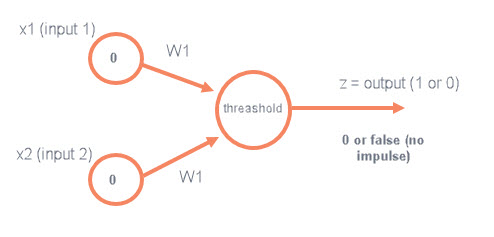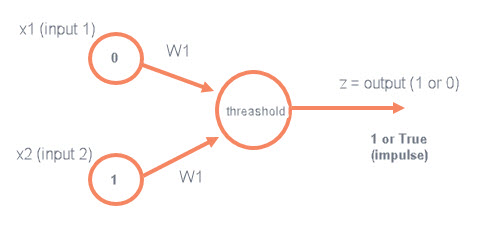Neural network perceptron simple example c#
Back to learning
Created: 25/05/2018




This is a very basic example how we can create a perceptron which will behave as an OR operator
0 or 0 = 0

1 or 0 = 1

0 or 1 = 1

1 or 1 = 1

Basically our perceptron will "fire" when:
(x1*w1 + x2*w2) > threashold
using System;
using System.Collections.Generic;
using System.Linq;
using System.Text;
using System.Threading.Tasks;
using System.Data;
namespace ai
{
class Program
{
static void Main(string[] args)
{
// Declaration and initial values (random)
Perceptron n = new Perceptron();
n.w1 = 0.2;
n.w2 = 0.2;
n.threshold = 0.5;
n.learnFactor = 0.2;
// Perceptron training
int iter = 0;
while (!IsOr(n))
{
if (iter == 0)
{
n.x1 = 0;
n.x2 = 0;
n.y = 0;
if (n.IsThreshold())
n.Adjust();
}
if (iter == 1)
{
n.x1 = 1;
n.x2 = 0;
n.y = 1;
if (!n.IsThreshold())
n.Adjust();
}
if (iter == 2)
{
n.x1 = 0;
n.x2 = 1;
n.y = 1;
if (!n.IsThreshold())
n.Adjust();
}
if (iter == 3)
{
n.x1 = 1;
n.x2 = 1;
n.y = 1;
if (!n.IsThreshold())
n.Adjust();
}
if (iter == 3)
iter = 0;
else
iter++;
}
// Testing
int seguir = 1;
while (seguir == 1)
{
Console.WriteLine("Type x1 value (0 or 1):");
n.x1 = Convert.ToInt32(Console.ReadLine());
Console.WriteLine("Type x2 value (0 or 1):");
n.x2 = Convert.ToInt32(Console.ReadLine());
if (n.IsThreshold())
{
Console.WriteLine("Result: 1");
}
else
{
Console.WriteLine("Resultado: 0");
}
Console.WriteLine("Do you want to continue? yes:1, no: <> 1");
seguir = Convert.ToInt32(Console.ReadLine());
}
}
/// <summary>
/// This function verifies if our perceptron is ready to work as OR operator
/// </summary>
/// <param name="per"></param>
/// <returns></returns>
public static bool IsOr(Perceptron per)
{
bool _00 = false;
bool _10 = false;
bool _01 = false;
bool _11 = false;
per.x1 = 0;
per.x2 = 0;
if (!per.IsThreshold())
{
_00 = true;
}
per.x1 = 1;
per.x2 = 0;
if (per.IsThreshold())
{
_10 = true;
}
per.x1 = 0;
per.x2 = 1;
if (per.IsThreshold())
{
_01 = true;
}
per.x1 = 1;
per.x2 = 1;
if (per.IsThreshold())
{
_11 = true;
}
Console.WriteLine("Data: ");
Console.WriteLine("w1: " + per.w1.ToString());
Console.WriteLine("w2: " + per.w2.ToString());
Console.WriteLine("threshold: " + per.threshold.ToString());
// to be valid, must be:
/*
* 00=0
* 01=1
* 10=1
* 11=1
*/
return (_00 && _10 && _01 && _11) ? true : false;
}
}
public class Perceptron
{
public double x1 { get; set; }
public double x2 { get; set; }
public double w1 { get; set; }
public double w2 { get; set; }
public double y { get; set; }
public double threshold { get; set; }
private double sum
{
get
{
return (x1 * w1) + (x2 * w2);
}
}
public double learnFactor { get; set; }
public void Adjust()
{
double e = y - sum; // expected - obtained
threshold += -(learnFactor * e);
w1 += learnFactor * e * x1;
w2 += learnFactor * e * x2;
}
public bool IsThreshold()
{
if (sum > threshold)
return true;
else
return false;
}
}
}